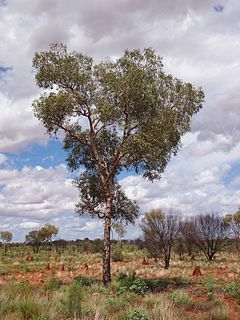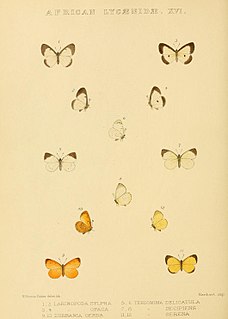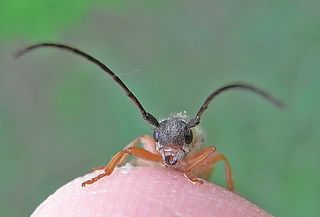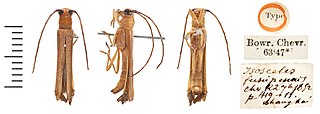Related Research Articles

Ilex opaca, the American holly, is a species of holly, native to the eastern and south-central United States, from coastal Massachusetts south to central Florida, and west to southeastern Missouri and eastern Texas.

The Micronesian starling is a species of starling in the family Sturnidae. It is found in Micronesia, the Northern Mariana Islands, and Palau. Its natural habitats are subtropical or tropical dry forest and subtropical or tropical moist lowland forest.

Corymbia opaca, also known as the desert bloodwood, is a species of tree that is endemic to northern Australia. It has rough bark on part or all of the trunk, lance-shaped leaves, club-shaped flower buds and urn-shaped fruit. Several parts of this plant are used by Aboriginal Australians in traditional medicine.

Oberea is a genus of longhorn beetles, most of which are stem borers of various plants, including blackberries and their relatives.

Liptena opaca, the Kirby's liptena, is a butterfly in the family Lycaenidae. It is found in Nigeria, Cameroon, Equatorial Guinea, the Republic of the Congo, Gabon, the Democratic Republic of the Congo, Uganda and Tanzania. The habitat consists of forests.

Clematicissus opaca, called small-leaf grape, pepper vine, small-leaved water vine, yaloone and wappo wappo, is a small vine endemic to Australia. Pepper vine is naturally found in rocky locales in monsoon forest, littoral rainforest and open forest, and is occasionally grown as a garden plant. The plant is primarily restricted to coastal and sub-coastal regions in Queensland and New South Wales, although it does occur inland, west of the Great Dividing Range, in central New South Wales,
Oberea consentanea is a species of beetle in the family Cerambycidae. It was described by Francis Polkinghorne Pascoe in 1867. It is known from Borneo.
Oberea inclusa is a species of beetle in the family Cerambycidae. It was described by Francis Polkinghorne Pascoe in 1858. It contains the varietas Oberea inclusa var. discipennis.
Oberea rubetra is a species of beetle in the family Cerambycidae. It was described by Francis Polkinghorne Pascoe in 1858. It is known from Sumatra, Borneo and Malaysia.
Oberea nigrocincta is a species of beetle in the family Cerambycidae. It was described by Per Olof Christopher Aurivillius in 1907.
Oberea erythrostoma is a species of beetle in the family Cerambycidae. It was described by Heller in 1915. It is known from the Philippines.

Oberea euphorbiae is a species of beetle in the family Cerambycidae. It was described by Ernst Friedrich Germar in 1813 originally under the genus Saperda. It has a wide distribution in Europe. It feeds on Euphorbia palustris.
Oberea ferruginea is a species of beetle in the family Cerambycidae. It was described by Thunberg in 1787.

Oberea fuscipennis is a species of beetle in the family Cerambycidae. It was described by Chevrolat in 1852.

Oberea linearis is a species of beetle in the family Cerambycidae. It was described by Carl Linnaeus in 1761, originally under the genus Cerambyx. It has a wide distribution throughout Europe. It is preyed upon by Opilo pallidus, and serves as a host for the parasitic wasp species Dolichomitus messor and Phaenolobus terebrator. It feeds on Juglans regia, Corylus avellana, Ulmus glabra, Ostrya carpinifolia, and Carpinus betulus. It contains the varietas Oberea linearis var. parallela.
Oberea pedemontana is a species of beetle in the family Cerambycidae. It was described by Chevrolat in 1856. It has a wide distribution in Europe. It feeds on Rhamnus alpina and Frangula alnus.
Oberea vittata is a species of beetle in the family Cerambycidae. It was described by Blessig in 1873. It is known from Russia, China, Mongolia, and Japan.

Aclypea opaca is a species of carrion beetle in the family Silphidae. It is found in Europe and Northern Asia and North America.
References
- ↑ BioLib.cz - Oberea opaca. Retrieved on 8 September 2014.